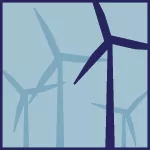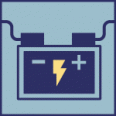Wind Energy Factsheet
Wind Resource and Potential
Approximately 2% of the solar energy striking the Earth’s surface is converted into kinetic energy in wind. Wind turbines convert the wind’s kinetic energy to electricity without emissions.1 The distribution of wind energy is heterogeneous, both across the surface of the Earth and vertically through the atmosphere. Average annual wind speeds of 6.5m/s or greater at 80m are generally considered commercially viable. New technologies, however, are expanding the wind resources accessible for commercial projects.3 In 2022, 10.2% of U.S. electricity was generated from wind energy, but wind capacity is increasing rapidly.4
- High wind speeds yield more power because wind power is proportional to the cube of wind speed.5
- Wind speeds are slower close to the Earth’s surface and faster at higher altitudes. The average hub height of modern wind turbines is 94 meters.6
- Global onshore and offshore wind generation potential at 90m turbine hub heights could provide 872,000 TWh of electricity annually.7 Total global electricity consumption from all sources in 2020 was about 23,966 TWh.8
- Similarly, the annual continental U.S. wind potential of 43,000 TWh greatly exceeds 2022 U.S. electricity consumption of 4,048 TWh.4,7
- A 2015 study by the U.S. Department of Energy found wind could provide 20% of U.S. electricity by 2030 and 35% by 2050.9
- Five of the eight Great Lakes states have lake-based wind energy resource potentials that exceed the state’s annual electricity consumption (MI, WI, NY, OH, MN). Michigan's Great Lakes resource potential could supply over 18 times its 2020 electricity demand.10
U.S. Wind Resources, Onshore and Offshore2 (80 METER HEIGHT)
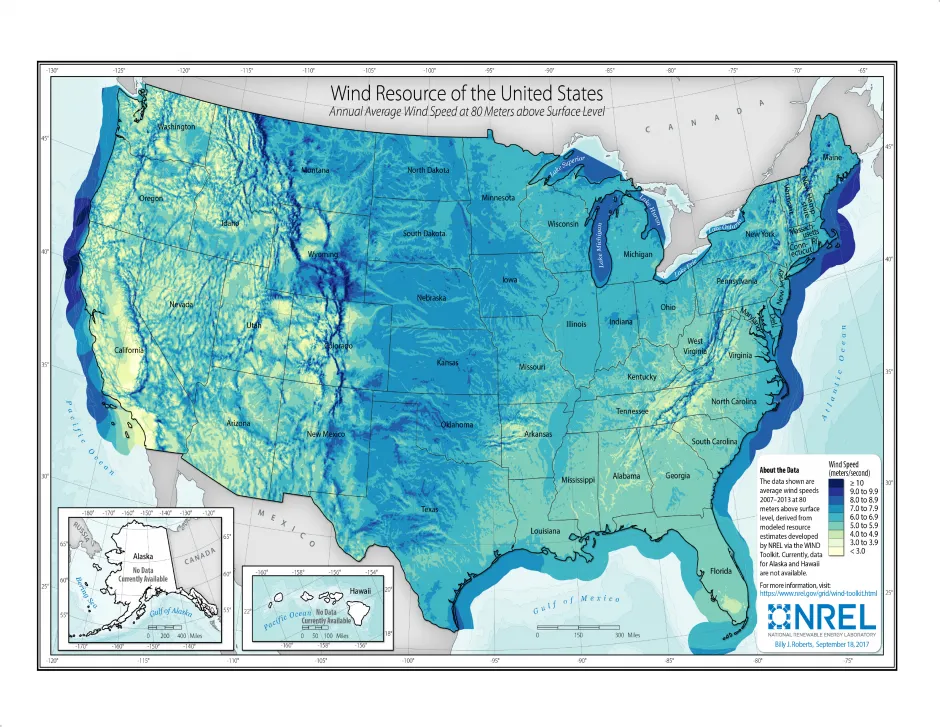
Wind Technology and Impacts
Horizontal Axis Wind Turbines
- Horizontal axis wind turbines (HAWT) are the predominant turbine design in use today.
- The HAWT rotor comprises blades (usually three) symmetrically mounted to a hub. The rotor is connected via a shaft to a gearbox and generator. The nacelle houses these components atop a tower.11
- HAWT come in a variety of sizes, ranging from 2.5 meters in diameter and 1 kW for residential applications to 100+ meters in diameter and 10+ MW for offshore applications.
- The theoretical maximum efficiency of a turbine is ~59%, also known as the Betz Limit. Most turbines extract ~50% of the energy from the wind that passes through the rotor area.9
- The capacity factor of a wind turbine is its average power output divided by its maximum power capability.9 Capacity factor of land based wind in the U.S. ranges from 21% to 52% and averages 35%.6
- Offshore winds are generally stronger than on land, and capacity factors are higher on average (expected to reach 60% by 2050 for new projects), but offshore wind farms are more expensive to build and maintain.13,14 Offshore turbines are currently placed in depths up to 40-50m (about 131-164ft), but floating offshore wind technologies could greatly expand generation potential as 58% of the total technical wind resource in the U.S. lies over waters greater than 60m.15,16
Horizontal Axis Wind Turbine Diagram11
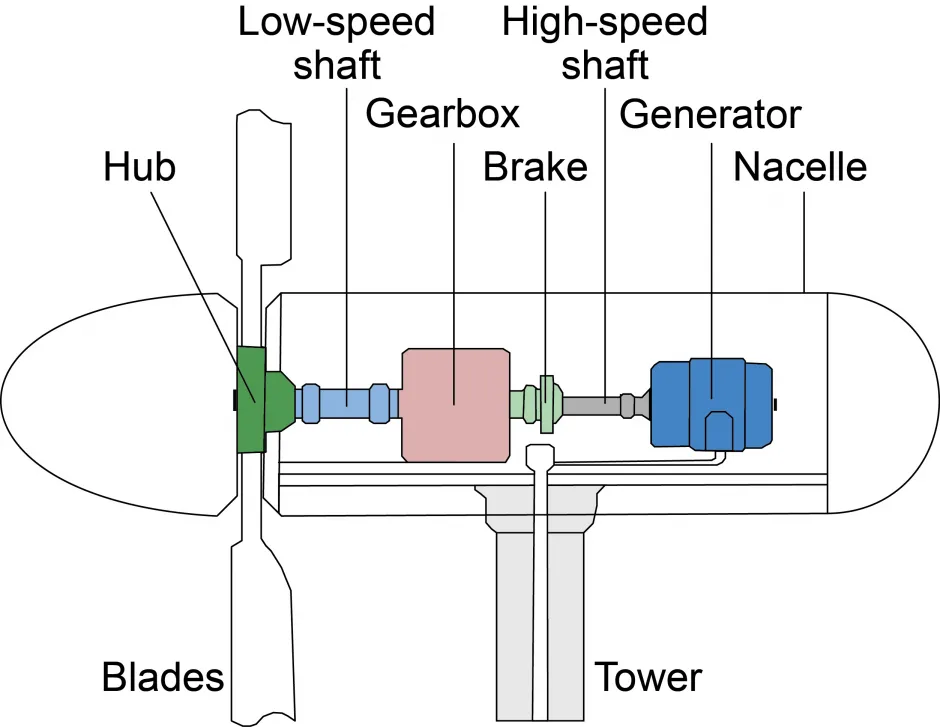
Installation, Manufacturing, and Cost
- The U.S. has a cumulative capacity of 142 GW with more than 72,000 installed utility-scale wind turbines. U.S. wind capacity grew from 40 GW in 2010 to 142 GW in 2022, a 11% average annual increase.17,18 Global wind capacity increased by 12% annually, on average, from 2012 to 2022, reaching 906 GW in 2022.19
- U.S. average turbine size was 3.0 MW in 2021, up 18% from 2.55 MW in 2019.6
- Average capacity factor has increased from 19% for projects installed from 1998 to 2001 to 39% for projects built between 2014 and 2020.6
- On a capacity-weighted average basis, wind project costs declined by roughly $3,303/ kW between 1983 and 2021, when costs were $1,500/kW.6
- The average installed cost of a small (<100 kW) turbine was approximately $5,120 per kW in 2021.20
- In 2020-21, new wind energy purchase contracts averaged 2.5¢/kWh, while the average residential electricity price was 15.1¢/kWh in 2021.4,6
- Minnesota (17,558 MW), Texas (17,167 MW), and California (16,385 MW) are the leading states in total installed wind capacity.17
- Iowa generated 62% of its electricity from wind and had the second highest annual electricity generation from wind of any U.S. state in 2022.21
- In 2021, there were more than 120,000 full-time workers in the U.S. wind industry and turbines and components were manufactured at over 500 facilities.22
- Large (>20 MW) wind projects require ~85 acres of land area per MW of installed capacity, but 1% or less of this area is occupied by roads, foundations, or equipment; the remainder is available for other uses.9
- For farmers, annual lease payments provide a stable income of around $3,000/MW of turbine capacity, depending on the number of turbines on the property, the value of the energy generated, and lease terms.9
U.S. Wind Capacity17
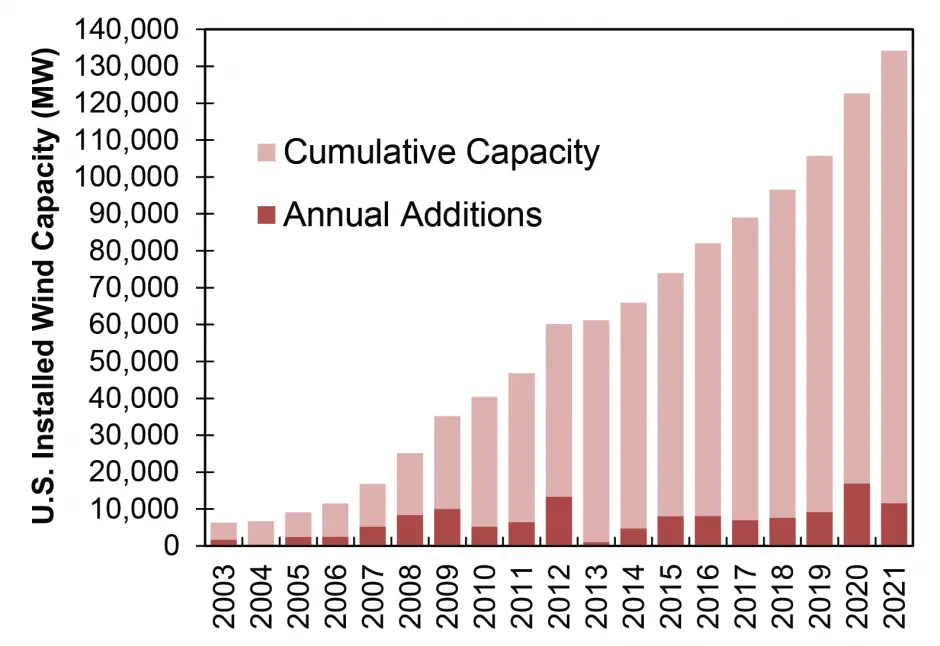
Global Wind Capacity, 202219
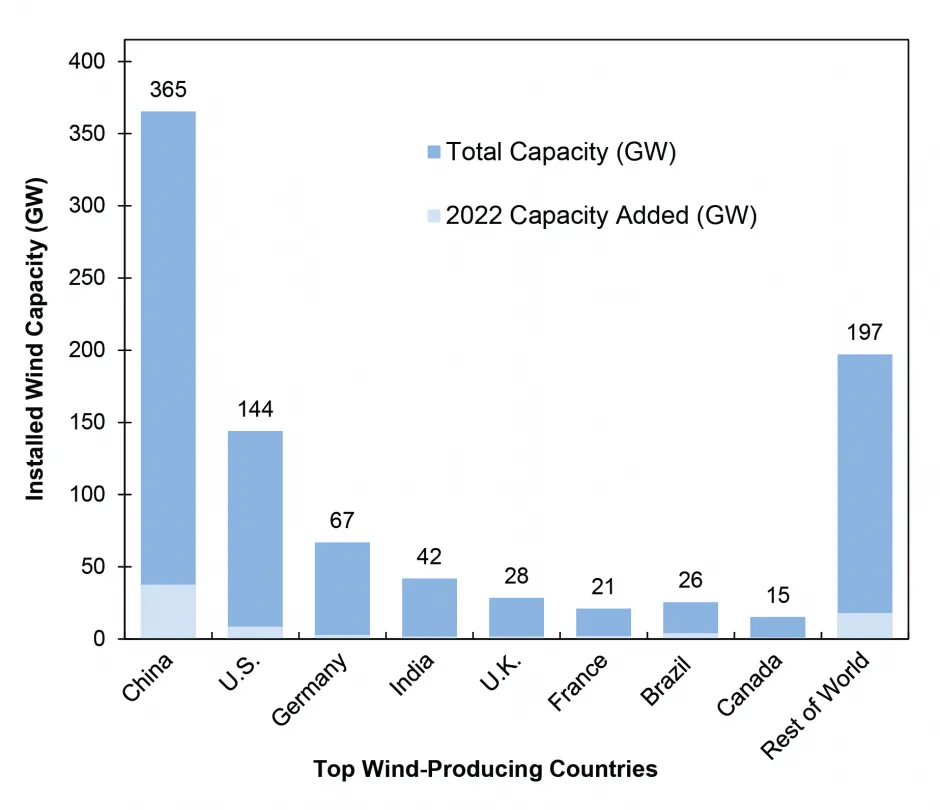
Energy Performance and Environmental Impacts
- Wind turbines can reduce the impacts associated with conventional electricity generation. The U.S. wind capacity avoids an estimated 340 million metric tons (Mt) of CO2 emissions annually.22
- According to a 2015 study, if 35% of U.S. electricity was wind-generated by 2050, electric sector GHG emissions would be reduced by 23%, eliminating 510 billion kg of CO₂ emissions annually, or 12.3 trillion kg cumulatively from 2013, and decreasing water use by 15%.9
- A 2013 study found energy return on investment (EROI) (energy delivered/energy invested) for wind power between 18:1 and 20:1.23
- Annual avian mortality from collisions with turbines is 0.2 million, compared with 130 million mortalities due to power lines and 300-1,000 million from buildings. The best way to minimize mortality is careful siting.9 Bat mortality due to wind turbines is less well studied. Research shows that a large percentage of bat collisions occur in migratory species during summer and fall months when they are most active.9,24 The wind industry has been testing methods that potentially reduce bat mortality by more than 50%.9
- Noise 350m from a typical wind farm is 35-45 dB. For comparison, a quiet bedroom is 35 dB and a 40 mph car 100m away is 55 dB.25
- As of 2013, several studies have conclusively determined that sound generated by wind turbines has no impact on human health.9
- Offshore turbine foundations and transmission cables alter benthic habitats, but foundations can create pelagic habitats. Appropriate siting of offshore wind farms is the most effective way to avoid conflicts.26
Solutions and Sustainable Actions
Policies Promoting Renewables (See Renewable Energy Factsheet)
Policies that support wind and other renewables can address externalities associated with conventional electricity, such as health effects from pollution, environmental damage from resource extraction, and long-term nuclear waste storage.
- Renewable Portfolio Standards (RPS) require electricity providers to obtain a minimum fraction of energy from renewable resources.27
- Feed-in tariffs set a minimum price per kWh paid to renewable electricity generators by retail electricity distributors.27
- Net metering — offered in 39 states, D.C., and four U.S. territories — allows customers to sell excess electricity back to the grid.28
- Capacity rebates are one-time, up-front payments for building renewable energy projects, based on the capacity (in watts) installed.
- The 2022 Inflation Reduction Act (IRA) extended and increased the production tax credit (PTC) and investment tax credit (ITC) through 2024 for wind energy projects that begin construction before 2025. The PTC provides up to 2.6¢/kWh of electricity generated and the ITC provides up to 30% of the project's initial investment cost.29 These tax credits are dependent on the size of the project, construction start date, and in some cases whether certain wage and apprenticeship requirements have been satisfied.30
- Section 9006 of the Farm Bill is the Rural Energy for America Program (REAP) that funds grants and loan guarantees for agricultural producers and rural small businesses to purchase and install renewable energy systems.31
- System benefits charges are paid by all utility customers to create a fund for low-income support, renewables, efficiency, and R&D projects that are unlikely to be provided by a competitive market.32
- The first U.S. commercial offshore wind farm began delivering electricity in 2016. In 2020, a second offshore wind farm completed installation. As of May 2022, 9 states have offshore wind projects seeking leasing status.33
What You Can Do
- Make your lifestyle more efficient to reduce the amount of energy you use.
- Invest in non-fossil electricity generation infrastructure by purchasing “green power” from your utility.
- Buy Renewable Energy Certificates (RECs). RECs are sold by renewable energy producers for a few cents per kilowatt hour, customers can purchase RECs to “offset” their electricity usage and help renewable energy become more competitive.27
- Consider installing your own wind system, especially if you live in a state that provides financial incentives or has net metering.
Center for Sustainable Systems, University of Michigan. 2023. "Wind Energy Factsheet." Pub. No. CSS07-09.
References
- Gustavson, M. (1979) “Limits to Wind Power Utilization.” Science, 204(4388): 13-17.
- U.S. Department of Energy (DOE), National Renewable Energy Lab (NREL) (2017) U.S. Wind Resource Map.
- U.S. DOE, Energy Efficiency and Renewable Energy (EERE) (2020) “U.S. Average Annual Wind Speed at 80 Meters.”
- U.S. Energy Information Administration (EIA) (2023) Monthly Energy Review April 2023.
- Massachusetts Institute of Technology (2010) Wind Power Fundamentals.
- U.S. DOE, Lawrence Berkeley National Lab (LBNL) (2022) Land-Based Wind Market Report.
- NREL (2017) An Improved Global Wind Resource Estimate for Integrated Assessment Models.
- U.S. EIA (2023) International Energy Statistics: Total Electricity Net Consumption.
- U.S. DOE (2015) Wind Vision Report.
- NREL (2023) Great Lakes Wind Energy Challenges and Opportunities Assessment.
- U.S. DOE, Wind Energy Technologies Office (2023) “How a Wind Turbine Works - Text Version”
- U.S. DOE, NREL (2015) “Transparent Cost Database: Capacity Factor” Open Energy Information.
- International Renewable Energy Agency (2019) Future of Wind Executive Summary.
- NREL (2022) 2021 Cost of Wind Energy Review.
- International Renewable Energy Agency (2018) Offshore Innovation Widens Renewable Energy Options.
- U.S. DOE, NREL (2016) 2016 Offshore Wind Energy Resource Assessment for the United States.
- U.S. EIA (2023) Preliminary Monthly Electric Generator Inventory March 2023.
- Hoen, B.D., et al. 2018, United States Wind Turbine Database v6.0 (2023) U.S. Geological Survey, American Clean Power Association, and Lawrence Berkeley National Laboratory data release, https://doi.org/10.5066/ F7TX3DN0.
- Global Wind Energy Council (GWEC) (2023) Global Wind Report 2023.
- U.S. DOE, Pacific Northwest National Lab (PNNL) (2022) Distributed Wind Market Report 2022 Edition Summary.
- U.S. EIA (2023) Electric Power Monthly February 2023.
- ACP (2023) "Wind Power Facts."
- Hall, C., et al. (2013) EROI of different fuels and the implications for society. Energy Policy (64), 141-152.
- U.S. Geological Survey, Fort Collins Science Center (2016) “Bat Fatalities at Wind Turbines: Investigating the Causes and Consequences.”
- U.S. DOE, EERE (2008) 20% Wind Energy by 2030: Increasing Wind Energy’s Contribution to U.S. Electricity Supply.
- European Commission (2020) Guidance Document on Wind Energy Developments and EU Nature Legislation.
- U.S. EPA (2021) “State Renewable Energy Resources.”
- DSIRE (2021) Net Metering Policies.
- U.S. DOE, EERE (2022) "Production Tax Credit and Investment Tax Credit For Wind Energy."
- U.S. DOE, EERE (2023) WETO Funding Fact Sheet: Advancing the Growth of the U.S. Wind Industry: Federal Incentives, Funding, and Partnership Opportunities.
- DSIRE (2018) “USDA - Rural Energy for America Program (REAP) Grants.”
- DSIRE (2016) “Glossary.”
- U.S. Bureau of Ocean Energy Management (2021) State Activities
